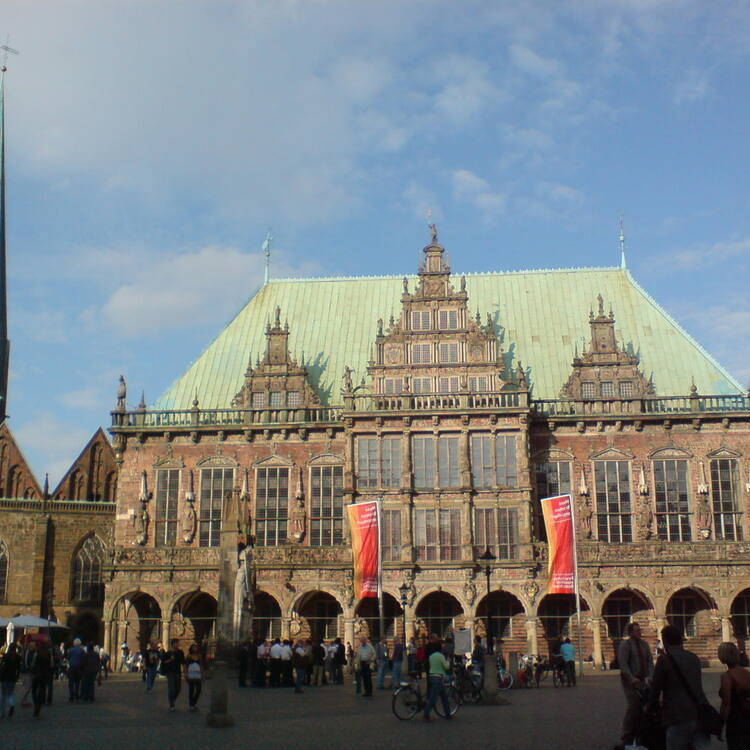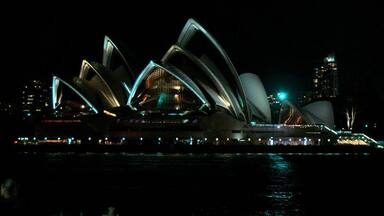Town Hall and Roland on the Marketplace of Bremen
Town Hall and Roland on the Marketplace of Bremen
The Town Hall and the statue of Roland on the marketplace of Bremen in north-west Germany are outstanding representations of civic autonomy and sovereignty, as these developed in the Holy Roman Empire in Europe. The old town hall was built in the Gothic style in the early 15th century, after Bremen joined the Hanseatic League. The building was renovated in the so-called Weser Renaissance style in the early 17th century. A new town hall was built next to the old one in the early 20th century as part of an ensemble that survived bombardment during the Second World War. The statue stands 5.5 m tall and dates back to 1404.
Description is available under license CC-BY-SA IGO 3.0
Hôtel de ville et la statue de Roland sur la place du marché de Brême
L’hôtel de ville et la statue de Roland sur la place du marché de Brême au nord-ouest de l’Allemagne constituent des témoignages exceptionnels de l’autonomie civique et de la souveraineté qui caractérisèrent le Saint Empire romain germanique. L’ancien bâtiment de l’hôtel de ville a été construit en style gothique au début du XVe siècle, après que Brême fut devenu membre de la Ligue hanséatique. Le bâtiment a été remanié au début du XVIIe siècle dans le style appelé Renaissance de la Weser. Un nouvel hôtel de ville, construit à côté de l’ancien au début du XXe siècle, fait partie d’un ensemble épargné par les bombardements de la Seconde Guerre mondiale. La statue, haute de 5,5 m, remonte à 1404.
Description is available under license CC-BY-SA IGO 3.0
مبنى البلدية وتمثال رولان في ساحة سوق بريمن
يُعتبر مبنى البلدية وتمثال رولان في ساحة بريمن في شمال غرب المانيا شهادة استثنائية للاستقلالية المدنية والسيادة اللتين تميّزان الإمبراطورية الرومانية الجرمانية المقدّسة. تمّ بناء مبنى البلدية القديم على الطراز القوطي في بداية القرن الخامس عشر بعد أن أصبحت بريم عضوًا في رابطة الهانزا. وأعيد تعديل البناء في القرن السابع عشر ليتبع طراز النهضة في ويزر. ويدخل مبنى البلديّة الجديد الذي تمّ تشييده بالقرب من القديم في بداية القرن العشرين ضمن المجموعة التي لم يطلها القصف خلال الحرب العالمية الثانية. ويعود التمثال الذي يبلغ 5.5 متر طولاً إلى العام 1404.
source: UNESCO/CPE
Description is available under license CC-BY-SA IGO 3.0
不来梅市市场的市政厅和罗兰城
德国西北部不来梅市市场的市政厅和罗兰骑士雕像是公民自治权利和贸易自由权利的象征,这些是随神圣罗马帝国在欧洲发展起来的。不来梅市政厅是15世纪初不来梅加入汉萨同盟(the Hanseatic League)后建立的,为哥特式建筑风格,于17世纪初翻修成了所谓的“威悉文艺复兴”(Weser Renaissance)风格。20世纪初,在老市政厅旁修建了一个新厅,成为第二次世界大战期间免遭炮火轰击的建筑之一。罗兰骑士雕像高5.5米,其历史可追溯到1404年。
source: UNESCO/CPE
Description is available under license CC-BY-SA IGO 3.0
Ратуша и статуя Роланда на Рыночной площади в городе Бремен
Городская ратуша и статуя Роланда на Рыночной площади в городе Бремен на северо-западе Германии являются выдающимися свидетельствами гражданских и торговых прав городов, сложившихся в Священной Римской империи в Европе. Старая ратуша была построена в готическом стиле в начале XV в., вскоре после того, как Бремен присоединился к Ганзейскому союзу. Позднее, в начале XVII в., она была реконструирована в так называемом стиле «Везерского Возрождения». В начале ХХ в. новую ратушу выстроили рядом со старой как часть единого ансамбля, который уцелел при бомбежках времен Второй Мировой Войны. Статуя высотой 5,5 м относится к 1404 г.
source: UNESCO/CPE
Description is available under license CC-BY-SA IGO 3.0
Ayuntamiento y estatua de Rolando en la plaza del mercado de Bremen
El edificio del ayuntamiento de Bremen y la estatua de Rolando, ubicados en la plaza del mercado de esta ciudad del noroeste de Alemania, son dos obras muy representativas de las tradiciones de autonomía cívica y soberanía del Sacro Imperio Romano Germánico. El antiguo edificio del ayuntamiento fue construido en estilo gótico a comienzos del siglo XV, después de la adhesión de la ciudad a la Liga Hanseática. Más tarde, a principios del siglo XVII, el edificio fue renovado según el estilo renacentista típico de la región del río Weser. A principios del siglo XX se construyó un nuevo ayuntamiento junto a este antiguo edificio municipal, constituyendo así un conjunto arquitectónico que salió indemne de los bombardeos de la Segunda Guerra Mundial. La estatua, esculpida en 1404, tiene una altura de 5,5 metros.
source: UNESCO/CPE
Description is available under license CC-BY-SA IGO 3.0
ブレーメンのマルクト広場の市庁舎とローラント像
ドイツ北西部に位置するブレーメン。そのマルクト広場にある旧市庁舎とローランド像は、神聖ローマ帝国の下での市民権と商業権の伸張を象徴する建造物である。旧庁舎は、15世紀初期にブレーメンがハンザ同盟に加盟した後に建設されたゴシック様式の建築だったが、17世紀初期に、北ドイツ隆盛したヴェーザー・ルネサンス様式に改装された。現在の庁舎は、旧庁舎に隣接して全体の調和をはかって20世紀初期に建設されたもので、第2次世界大戦の戦火を免れた。ブレーメンの都市の自覚と帝国に属したことの誇りを象徴する高さ5.5mのローラント像は、1404年に建てられた。source: NFUAJ
Stadhuis en Roland-standbeeld op het marktplein van Bremen
Het stadhuis en het standbeeld van Roland (de paladijn van Karel de Grote) – daterend van 1404 en 5,5 meter hoog – op het marktplein van Bremen, in het noordwesten van Duitsland, tonen de burgerlijke autonomie en soevereiniteit zoals die zich ontwikkelde in het Heilige Roomse rijk in Europa. Het oude stadhuis werd in het begin van de 15e eeuw gebouwd in gotische stijl, nadat Bremen een Hanzestad werd. Het gebouw werd in de vroege 17e eeuw gerenoveerd in de zogenaamde Weser renaissancestijl. Aan het begin van de 20e eeuw werd er een nieuw stadhuis gebouwd naast het oude.
Source: unesco.nl
Outstanding Universal Value
Brief synthesis
The Town Hall and Roland on the marketplace of Bremen in north-west Germany are an outstanding representation of the civic autonomy and market rights as they developed in the Holy Roman Empire in Europe. The Old Town Hall was built as a Gothic hall structure in the early 15th century, and renovated in the so-called Weser Renaissance style in the early 17th century. A New Town Hall was built next to the old one in the early 20th century as part of an ensemble that survived the bombardments during the Second World War.
The Old Town Hall is a two-storey hall building with a rectangular floor plan, 41.5 m by 15.8 m. It is described as a transverse rectangular Saalgeschossbau (i.e. a multi-storey construction built to contain a large hall). The ground floor is formed of one large hall with oak pillars; it served for merchants and theatrical performances. The upper floor has the main festivity hall of the same dimensions. Between the windows, there are stone statues representing the emperor and prince electors, which date from the original Gothic period, integrated with late-Renaissance sculptural decoration symbolising civic autonomy. Underground, the town hall has a large wine cellar with one hall in the dimensions of the ground floor with stone pillars, which was later extended to the west and is now used as a restaurant.
In the 17th century, the Town Hall was renovated, and out of the eleven axes of the colonnade the three middle ones were accentuated by a bay construction with large rectangular windows and a high gable, an example of the so-called Weser Renaissance. An elaborate sculptural decoration in sandstone was added to the façade, representing allegorical and emblematic depictions.
The New Town Hall was the result of an architectural competition, designed by Gabriel von Seidl from Munich, and built between 1909 and 1913. The stone statue of Roland was initially erected in 1404 in representation of the rights and privileges of the free and imperial city of Bremen. The statue of Roland is associated with the Margrave of Brittany, a paladin of Charlemagne.
Criterion (iii): The Bremen Town Hall and Roland bear an exceptional testimony to the civic autonomy and sovereignty, as these developed in the Holy Roman Empire.
Criterion (iv): The Bremen Town Hall and Roland are an outstanding ensemble representing civic autonomy and market freedom. The town hall represents the medieval Saalgeschossbau-type of hall construction, as well as being an outstanding example of the so-called Weser Renaissance in Northern Germany. The Bremen Roland is the most representative and one of the oldest of Roland statues erected as a symbol of market rights and freedom.
Criterion (vi): The ensemble of the Town Hall and Roland of Bremen with its symbolism is directly associated with the development of the ideas of civic autonomy and market freedom in the Holy Roman Empire. The Bremen Roland is referred to a historical figure, paladin of Charlemagne, who became the source for the French ‘chanson de geste’ and other medieval and Renaissance epic poetry.
Integrity
While the immediate surroundings of the Town Hall have survived reasonably well, the rest of the historic town of Bremen suffered serious destruction during the Second World War, and was rebuilt in new forms after the war. The Town Hall contains all elements necessary to express the property’s Outstanding Universal Value and the size is adequate to ensure complete representation. There are no adverse impacts of development and/or neglect.
Authenticity
The Town Hall of Bremen has had various phases in its history, starting with the first construction in Gothic style, in the early 15th century, and the substantial renovation in the Baroque period in the early 17th century. Furthermore, there have been various transformations and additions in the subsequent centuries, including the construction of the New Town Hall in the early 20th century. Taking into account this historical evolution, the Town Hall can be conceived as having historical authenticity in its form and material in respect to the various periods. It has also retained its historically established spatial relationship with the neighbouring historic buildings and market squares.
The Bremen Roland is considered to be one of the oldest and most representative still standing of such statues. It has been repaired and restored numerous times, and some of the original material has been replaced, therefore losing part of its authenticity.
Protection and management requirements
The Town Hall and the Roland are under the protection of the Law for the care and protection of cultural monuments (Denkmalschutzgesetz, DSchG, 1975/ 1989)) of the Federal Land of Bremen, and are listed as historic monuments. The property has been under preservation order since 1909 (Old Town Hall) and 1973 (New Town Hall). A buffer zone has been defined to ensure the effective protection of the important views of the property. The owner of the Town Hall and the Roland is the municipality of the Free Hanseatic City of Bremen.
In the city-state of Bremen the Bremen Monuments Office (Landesamt für Denkmalpflege) is the executing agency of the aforementioned law. It functions as a specialised monument authority and has the power to decide on the approval of applications submitted by monument owners in agreement with these owners. Once an agreement is reached, the superior authority, Senator for Culture (Senator für Kultur), takes the final decision. In accordance with international conservation principles, the Town Hall has repeatedly undergone repair and maintenance. There was a comprehensive restoration of the exterior from 2001 to 2006, including re-pointing the joints and consolidating the stone parts on the façades and repair of the copper roof.
The Management Plan of the property is regularly reviewed and updated when required.



